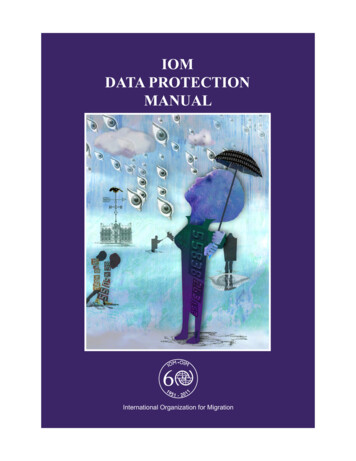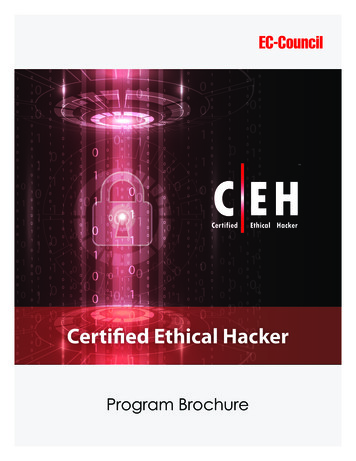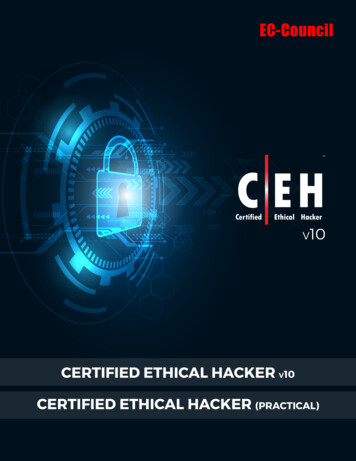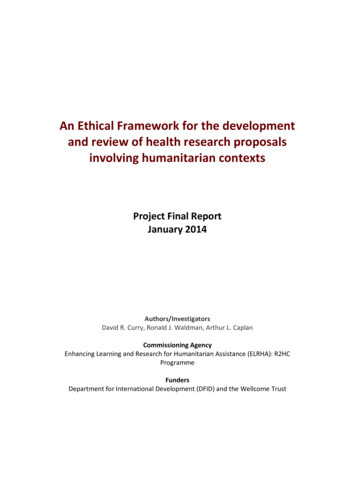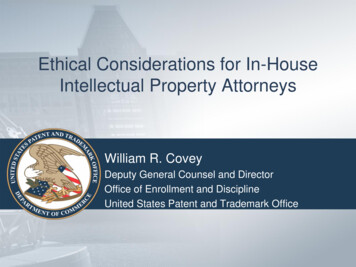
Transcription
Ethical Considerations for In-HouseIntellectual Property AttorneysWilliam R. CoveyDeputy General Counsel and DirectorOffice of Enrollment and DisciplineUnited States Patent and Trademark Office
Authority for OED to PursueDiscipline of Practitioners Practitioners are subject to discipline for not complying with USPTOregulations, regardless of whether their conduct was related to practicebefore the Office: In re Kenneth Graham, Proceeding No. D2013-09 (July 17, 2013). Patent attorney provided incompetent representation in bankruptcycases and violated local court rules and California law, including“cramdown” loan modifications, excessive fees, and unauthorized useof cash collateral. 2-year suspension after 2-year ban by U.S. Bankruptcy Court (N.D.California) and 10 year ban from all Chapter 11 cases. In re George Reardon, Proceeding No. D2012-19 (June 4, 2012). Patent agent excluded upon consent for misappropriation of non-profitorganization’s funds and use of organization’s credit card for personaluse.2
OED Discipline:America Invents Act The AIA amended 35 U.S.C. § 32 to require disciplinaryproceedings to be commenced not later than the earlier of: 10 years after the misconduct occurred, or One year from when the misconduct was made known to theUSPTO. 37 C.F.R. § 11.34(a) explains that disciplinary proceedings beginwith the filing of a complaint. 37 C.F.R. § 11.34(d) specifies that the timing for filing a complaintshall be within one year after the date on which the OED Directorreceives a grievance. 37 C.F.R. § 11.1 defines “grievance” as a “written submission fromany source received by the OED Director that presents possiblegrounds for discipline of a specified practitioner.”3
The USPTO Rules of Professional Conduct Final Rules Effective: May 3, 2013. 78 Federal Register 20179. 37 C.F.R. §§ 11.101-901. Old rules (37 C.F.R. Part 10) apply to activityprior to effective date. Based on 2011 Update to ABA Model Rules. Comments and Annotations to ABA ModelRules: non binding, but may be usefulinformation.4
USPTO Rules of ProfessionalConduct: 37 C.F.R. Part 11 Section 1: Client – Practitioner Relationship – §§ 11.101-11.118.Section 2: Counselor – §§ 11.201, 11.203-204.Section 3: Advocate – §§ 11.301-11.307, 11.309.Section 4: Transactions with Persons Other Than Clients§§ 11.401-11.404.Section 5: Law Firms and Associations – §§ 11.501-11.507.Section 7: Information About Legal Services – §§ 11.701-11.705.Section 8: Maintaining the Integrity of the Profession§§ 11.801-11.804.Savings Clause – § 11.901. Georgia Rules of Professional Conduct track with organization ofUSPTO Rules.5
Duty of Disclosure Bob is a registered practitioner and in-house IPcounsel for Company A. He prosecutes all ofCompany A’s patent applications at the USPTO. Aspart of the legal department, Bob also assists ongeneral litigation and other legal matters forCompany A, when needed. While assisting with a litigation matter, Bob learnsconfidential information that is material to thepatentability of claims pending in one of CompanyA’s patent applications. Management of Company A has told Bob that theydo not want this information disclosed to the USPTO.6
Conflicts of Interest Widget Corp. hires Law Firm X to defendagainst a patent infringement suit brought byResearch Inc. However, Law Firm X haspreviously performed patent prosecution workfor Research Inc. and still holds power ofattorney for some of Research Inc.’s patents.7
Power of Attorney Company B is represented by BigFirm in various patentprosecution matters. However, Company B did not assignpower of attorney to BigFirm for these matters.Accordingly, BigFirm generally filed papers in arepresentative capacity. See 37 CFR § 1.34. BigFirm now wants to represent Company X, which wouldpose a conflict with Company B. Accordingly, Company Bfires BigFirm and transfers all of its matters to NewFirm,but again puts off changing correspondence addresses forthe matters or assigning a new power of attorney toNewFirm. BigFirm continues to receive correspondence from theUSPTO for Company B’s applications.8
Customer Numbers Canada Corp. uses Midwest Firm, PC for their U.S. patentprosecution matters. All of Canada Corp’s work is done inMidwest Firm’s Chicago office. Midwest Firm hires new patent attorney Robin, primarily as apatent litigator, in its St. Louis office. At her former firm, Robinperformed minimal work on patent prosecution matters for acompetitor of Canada Corp. Midwest Firm decides that Robin will not be allowed to work onany of Canada Corp’s matters. However, Midwest Firm uses asingle customer number for all client power of attorney ande-business purposes at the USPTO. Because Robin is a registered practitioner, Midwest Firm wantsto put Robin on their customer number so she can participate inselect prosecution matters.9
Terminating Representation Company Y employs Firm A to handle all of its patentprosecution matters at the USPTO. Firm A employsone registered patent practitioner, Gail, who is the onlyperson associated with Firm A’s USPTO customernumber. Gail gives Firm A notice that she is leaving totake an in-house position with WidgetCorp in 2 weeks.Company Y uses Firm A for a variety of legal needsand wants to continue to use Firm A for patent work.10
Unauthorized Practice of Law Brian is a trademark paralegal and works with inhouse trademark counsel at Company X. As part ofhis daily responsibilities, Brian handles telephonecalls for the attorney relating to trademark matters.One day Brian receives a telephone call from aTrademark Examining Attorney. The TrademarkExamining Attorney proposes a minor amendmentthat would place a pending trademark application inpublishable condition.11
EnforcementEthics Enforcement at OED12
OED Discipline:Grievances An investigation may be initiated pursuant to informationfrom any source suggesting possible grounds fordiscipline. 37 C.F.R. § 11.22(a). Common Sources of Information:– External to USPTO: Clients, Colleagues, Others.– Internally within USPTO: Patent Corps, TrademarkCorps, Other.– Other: Published Decisions, News Articles. Duty to report professional misconduct:– 37 C.F.R. § 11.80313
Total Number ofOED Disciplinary DecisionsBreakdown of Reciprocal vs.Non-Reciprocal Formal DecisionsFY12FY13FY1414
Total Number ofOED Disciplinary DecisionsBreakdown of DisciplinaryDecisions by Practitioner TypeFY12FY13FY1415
OED Disciplinary DecisionsFY12FY13FY1416
Frequent Causes of Grievances Neglect Dishonesty, Fraud, Deceit, Misrepresentation Fee-Related Issues Unauthorized Practice of Law17
Examples of Neglect Failure to reply to Office actions Failure to communicate with client Duty to reply to client inquiries Duty to report Office communications Failure or delay in filing patent application Failure to revive or assist in revivingabandoned applications Failure to turn over files to newrepresentative18
Examples of Neglect In re Frantz (USPTO D2012-28)– Patent and trademark attorney; disciplinary complaint alleged: Neglected 33 patent and 19 trademark matters. Allowed applications to go abandoned without informing clients.– Excluded from practice before the USPTO. In re Tachner (USPTO D2012-30)– Patent attorney; disciplinary complaint alleged: Failed to report Office communications and docket due dates. Apps. became abandoned; patents expired for failure to pay maint. fees. Used handwritten docket book and “white board” for docketing USPTO duedates; later simple MS Word document was used. Staff was undertrained and underequipped.– Suspended from practice before USPTO for 5 years. Internal organization, systems, and office structure are important. Practitioners are responsible for using adequate staff andequipment to handle client matters.19
Examples of Dishonesty, Fraud, Deceit orMisrepresentation Concealing information from client, e.g., Date of Office actionDate of abandonmentReason for abandonmentMisrepresenting to client status of abandonedapplication as pending Making false or misleading statements toUSPTO, e.g., In advocacy before examiners, TTAB, PTABTo revive abandoned applicationTo obtain extension of time for replyIn response to an OED inquiry20
Examples of Dishonesty, Fraud,Deceit or Misrepresentation In re Hicks (USPTO D2013-11)– Trademark attorney: Sanctioned by EDNY for non-compliance with discovery orders. Federal Circuit affirmed sanction and found appellate brief to contain“misleading or improper” statements.– Received public reprimand and one-year probation. In re Reardon (USPTO D2012-19)– Patent agent; Disciplinary complaint alleged: Misappropriated at least 116,894 from non-profit org. for personal use. Used non-profit’s credit card for personal use without authorization. Submitted false annual financial reports to conceal his conduct.– Excluded from practice before the USPTO. In re Chan (USPTO D2011-21)– Patent agent: Had clients sign oaths or declarations prior to any application preparation.– Received public reprimand.21
Examples of Dishonesty, Fraud,Deceit or Misrepresentation In re Goldstein (USPTO D2014-10)– Patent attorney; disciplinary complaint alleged: Falsely informed clients he filed patent and TM applicationson their behalf and that applications were being examined. Created and sent clients fake filing receipts for patentapplications. Created fake cease and desist letters allegedly sent topotential infringers. Created phony response to fictitious inquiry from patentexaminer. Billed clients for services he did not perform and fees he didnot pay.– Excluded from practice before the USPTO.22
Examples of Fee-Related Issues Repeated failure to reply to fee-related Missing Parts Failure to return client’s advanced fees Improper commingling of client’s advanced legal feeswith practitioner’s funds Checks returned or EFTs dishonored for insufficientfunds Failure to disclose fee escrow and businessrelationship with invention development companies Charging excessive interest on unbilled fees23
Examples of Fee-Related Issues In re Riley (USPTO D2013-04)- Patent attorney:- Client paid 2000 for patent application preparation and filing.- Attorney did nothing but kept money and ignored client.- Client obtained small-claims court judgment, but attorney ignored it.- Excluded from practice before the USPTO. In re Lane (USPTO D2013-07)- Patent agent:- Sent notice of charges for services rendered to client without demand forpayment, as parties were working on potential business relationship thatwould subsume the charges.- Later sent an invoice for the charges and added an 18% interest chargefrom first notice.- Because client was unaware that interest was accruing, interest chargewas excessive fee and disreputable conduct.- 18-month suspension added to earlier discipline.24
Examples of the UnauthorizedPractice of Law Non-attorneys practicing before the Office in TMmatters Patent agents practicing before the Office in TM matters. Unregistered individuals practicing before the Office inpatent matters Excluded or suspended attorneys/agents practicingbefore the Office in patent matters Foreign attorneys practicing before the Office in Patentor TM matters Patent agents practicing state law25
Examples of UPL In re Seto (USPTO D2009-38)- Patent agent:-Hired as patent examiner; did not inform OED, as required.Did not withdraw from all matters before the USPTO upon hiring.Continued to prosecute patent applications while working at the USPTO.Assisted in preparation of TM applications while working at USPTO.Knew practice before the Office was not permitted for employees.- For this and other misconduct, received 5-year suspension. In re Campbell (USPTO D2014-11)- Patent agent:- Represented person in Colorado matter involving DUI charges.- Attempted to claim he was “attorney in fact” for driver.- Sued City of Colorado Springs in civil court on behalf of driver.- Appeared on behalf of driver in license revocation hearing.- For this and other misconduct, excluded from practice before theUSPTO.26
Additional Examplesof Misconduct In re Tassan (USPTO D2003-10) In re Tendler (USPTO D2013-17)- Attorney left abusive voicemailmessages for 3 different TTABAdministrative Judges.-- Filed Rule 131 declaration re:actual reduction to practice.- Later learned from client that thefacts were not accurate.- Did not advise office in writing ofinaccuracy.Reprimanded and ordered tocomplete anger management. In re Druce (USPTO D2014-13)-– Non-lawyer assistant fabricatedfilings and office communications– Signed patent attorney’s signature to filings.– Failure to adequately supervisenon-lawyer assistant. 2 year stayed suspension and 2year probation upon reinstatement4 year suspension for conductprejudicial to the administration ofjustice.In re Caracappa (USPTO D201402).– Authorized subordinate to sendemail to PTAB judge regardingInter Partes Review withoutcopying opposing counsel.– Received public reprimand.27
Decisions Imposing Public DisciplineAvailable In FOIA Reading Room http://e-foia.uspto.gov/Foia/OEDReadingRoom.jsp In the field labeled “Decision Type,” select“Discipline” from the drop down menu. To retrieve all discipline cases, click “Get Info” (not the“Retrieve All Decisions” link). Official Gazette for Patents http://www.uspto.gov/news/og/patent og/index.jspSelect a published issue from the list, and click on the“Notices” link in the menu on the left side of the webpage.28
Contacting OEDFor Informal Inquiries, Contact OED at571-272-4097THANK YOU29
§§ 11.801-11.804. Savings Clause - § 11.901. Georgia Rules of Professional Conduct track with organization of USPTO Rules. 5 . Duty of Disclosure . Breakdown of Reciprocal vs. Non-Reciprocal Formal Decisions FY12 FY13 FY14 . Total Number of OED Disciplinary Decisions 15







